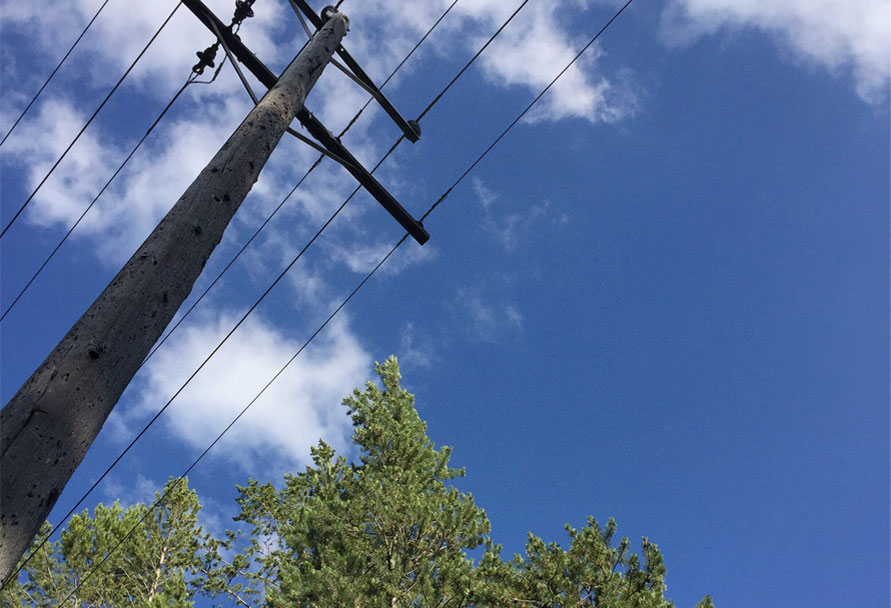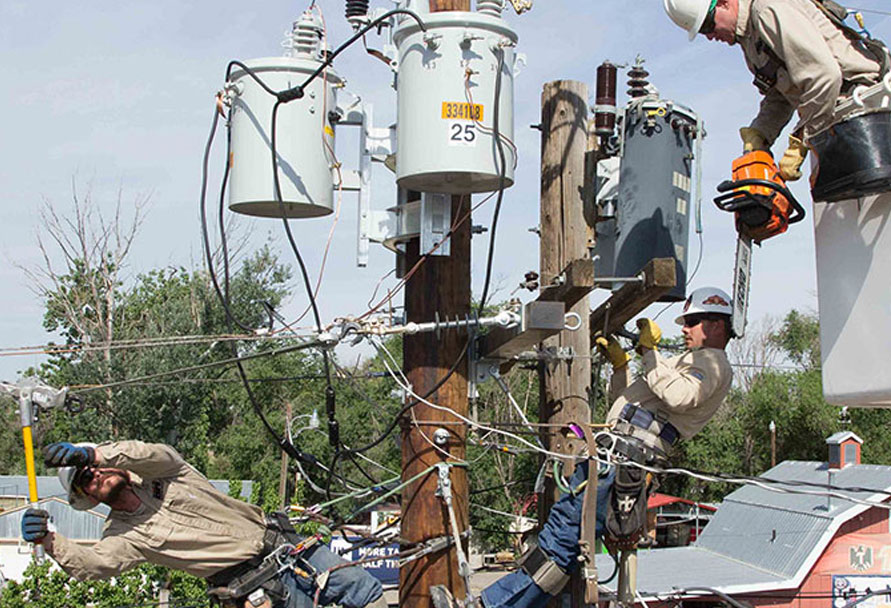Trimming trees safely

Electric lines are usually at the top of the pole, farthest from the ground. Cable TV and telephone lines run closer to the ground, below power lines. Contact your local cable and phone utilities to receive information about trimming requirements or any problems with these lines.
If you have trees that are already growing near power lines, it's important to trim them regularly to prevent them from growing into the lines.
Only certified line-clearance professionals are approved to work within 10 feet of energized power lines. All other professionals, arborists, tree trimmers and homeowners must not work within this zone. Contact the utility to make arrangements if a private tree service will be working on a tree with branches within 10 feet of an energized conductor.
When trimming trees near power lines, it's important to hire a qualified arborist. Arborists have the training and experience to safely trim trees near power lines.
How much a tree is trimmed depends on the tree species, voltage of power lines and how close branches are to those lines.
| VOLTAGE OF POWER LINES | GENERAL CLEARANCE SPECIFICATION |
|---|---|
| 230kV transmission power lines | 30 feet, or to the nearest lateral branch beyond the initially stated clearance, on each side of the outer most conductors |
| 69kV sub-transmission power lines | 20 feet, or to the nearest lateral branch beyond the initially stated clearance, on each side of the outer most conductors |
| Below 69kV distribution power lines | 15-20 feet for fast-growing trees (i.e., Siberian Elm, Box Elder, Silver Maple); 10 feet, or to the nearest lateral branch beyond the initially stated clearance, is the standard minimum approach distance for unqualified personnel |
| Secondary power lines | 1-3 feet of clearance |
Here are some tips for trimming trees safely near power lines:
- Never trim trees near power lines yourself.
- Hire a qualified Line Clearance Certified arborist to trim trees near power lines.
- Make sure the arborist has the proper safety equipment.
- Be aware of the location of underground power lines.
- Maintaining trees safely
In addition to planting and trimming trees safely, it's also important to maintain trees safely. This includes:
- Removing dead, diseased, or damaged trees.
- Pruning trees to remove branches that are hanging over power lines.
- Keeping trees watered and fertilized.
- Monitoring trees for signs of problems.
By following these tips, you can help keep your trees safe and your power on.
Why do we trim trees?
Trimming trees improves power reliability, reducing the number of outages in good conditions as well as bad weather, when reliability is most expected.
How are trees trimmed?
Our goal is to keep trees healthy while making sure they don't interfere with power lines. We follow the science-based lateral pruning method developed by the International Society of Arboriculture and approved by the National Arborists Association and National Arbor Day Foundation. Lateral pruning makes the overall structure of the tree stronger and more resistant to high winds and heavy ice loads. Future growth is directed away from power lines. We do not "top" trees, also known as “rounding over” or “shaping.” The National Arbor Day Foundation discourages topping because it makes trees more prone to co-dominate stems, narrow branch angles, weak attached branches, and disease and insect problems. The degree to which a tree is trimmed depends on multiple factors, including the tree species, the health of tree, voltage of power lines, proximity to the lines, and how close branches are to those lines.
Will I be notified of the tree trimming in my neighborhood?
Yes. An attempt to notify homeowners will be made. This could include a courtesy knock before commencement of work, an informative door hanger left by a work planner several weeks ahead of scheduled work or a tree removal request form.
Who cleans up the debris after tree trimming?
Tree limb debris is removed the day trimming occurs. If weather or equipment problems hinder debris removal, the contractor will notify the property owners or will leave a door hanger to let them know when they will return to finish cleaning up. We do not clean up debris in rural areas of our system or if the property owner is OK with leaving the debris. We also do not clean up debris after storms.
Will you ever cut down a tree?
Yes, with written permission. Trees near our electric facilities sometimes need to be removed rather than trimmed. If a tree is deemed to be a good candidate for removal, whether it is diseased, dying, storm damaged, likely to be severely deformed by necessary trimming, or in a spot that will cause future conflicts with the electric line, then or our contractor must obtain written permission from the owner of the tree to remove it. Trees near service lines that run to individual homes and businesses are the property owner’s responsibility and are not trimmed or removed.
Do you use herbicides?
Yes. After a tree with high re-sprout potential (i.e. Siberian Silver Maple, Cottonwood, Locust, etc.) is removed, the cut stump is treated with approved and applicable herbicide to prevent re-sprouting. Only certified contractors with proper herbicide application licenses are allowed to treat our rights-of-way as part of our “Integrated Vegetation Management” practices.
What is Integrated Vegetation Management?
Integrated Vegetation Management is using mechanical equipment, manual work and herbicides to manage power lines’ rights-of-way and to selectively control incompatible plant species in order to preserve low-growing grasses, herbs and woody shrubs. With proper management, low-growing vegetation eventually dominates the right-of-way. Studies show this type of meadow-like setting will enhance wildlife habitat by promoting vegetation preferred by birds, deer and other small animals while reducing the need for future treatments.
Why aren't more power lines underground?
Burying lines is about five to six times more expensive than overhead lines. Underground lines also require more space than overhead lines. Repairing underground lines can take much more time to restore than overhead lines.
Where should I plant trees to avoid future problems?
While trees grow to varying heights, it’s generally best to avoid planting trees under power lines. Before planting, visualize the height and spread of the tree in relation to nearby power lines. Also, for your safety, don't plant trees or large shrubs within 10 feet of a utility pole or pad mount transformer.
Can you legally access my property and trim trees?
Yes. Utility easements, or rights-of-way, exist on most properties allow public utilities to place facilities and to access/inspect and conduct maintenance to said facilities. Local, state and federal ordinances and statutes are also in place requiring and allowing utilities to repair, use, operate and maintain the utility’s electric or gas transmission lines. This includes the trimming and/or clearing of vegetation.
Who can I contact for tree trimming related questions?
You can call our customer service line at 888-890-5554.

Electric safety
Our power lines bring electricity to the communities we serve and in to your home or business. While we rely on electricity, we sometimes underestimate its force. Knowing a few basic rules can keep you safe around electricity.